As an Amazon Associate I earn from qualifying purchases. Please read the disclaimer for more info.
If there was one thing I wasn’t going to miss while spending a few months living in Hoi An, it was joining in a Vietnamese cooking class. And after quite a bit of research, the Hoi An Eco Cooking Class became the obvious choice.
But in this UNESCO World Heritage city, with the beautiful yellow walls, a centuries old ancient town, and a food culture that is as unique as it is broad, finding a cooking class to enhance my basic skills in Vietnamese cooking was a lot easier said than done.
There are cooking classes available all over town, in restaurants, or stand-alone schools. In the city, in the country-side. These days I have a short list of must-haves which make choosing a class easier:
– There needs to be a visit to a local market, farm, or some specialty store as part of the class
– There needs to be hands-on cooking involved. I’ve been to too many cooking demonstrations where I have been bored to tears.
– There needs to be a good representation of the local cuisine, and
– The class needs to be affordable and the operation well-organised.
– The Hoi An Eco Cooking Class had all these as well as a slew of great reviews.
What’s more, this cooking class also offered the following additional attractions;
– They are located in a quiet area outside of town along a water inlet where water coconut plants are grown
– Part of the experience is riding in a basket boat (thung chai) also known as a coracle, among the water coconut plants
– Students are given the chance to become a banh trang (rice paper) maker – more on that below.
Sounded good to me so I booked and waited for the day to come.
Hoi An Eco Cooking Class – The Experience
The day started early with a guided walk through of one of Hoi An’s local markets, Ba Le Market. The walkthrough included tasting some of the varied herbs used in Vietnamese cooking, an explanation of the fruits of Tet (the class was two days before Tet so the market was in full swing in preparation for the Lunar New Year), and some good information on when it is best to buy, and what to look for when choosing fresh seafood, shrimp in particular.
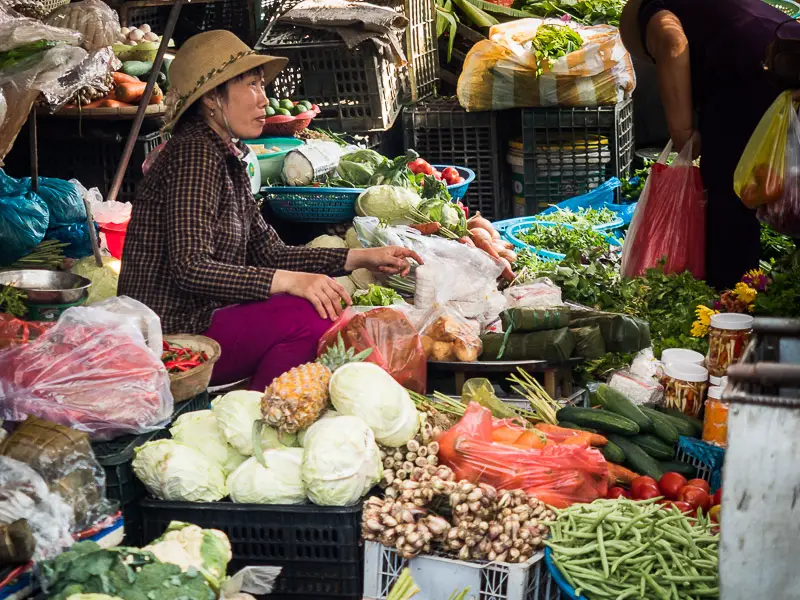
Vendor at Ba Le Market
From there we piled into two mini buses for the short 15 minute ride to the cooking school, located in a peaceful location running alongside an inlet near the ocean.
Before the cooking began, the group headed out onto the water in a basket boat (thung chai), also known as a coracle. My boat buddy mentioned that this was on her list of things to do while she and her friends were in Vietnam, so this could be a factor in choosing one of the cooking classes that include this option.
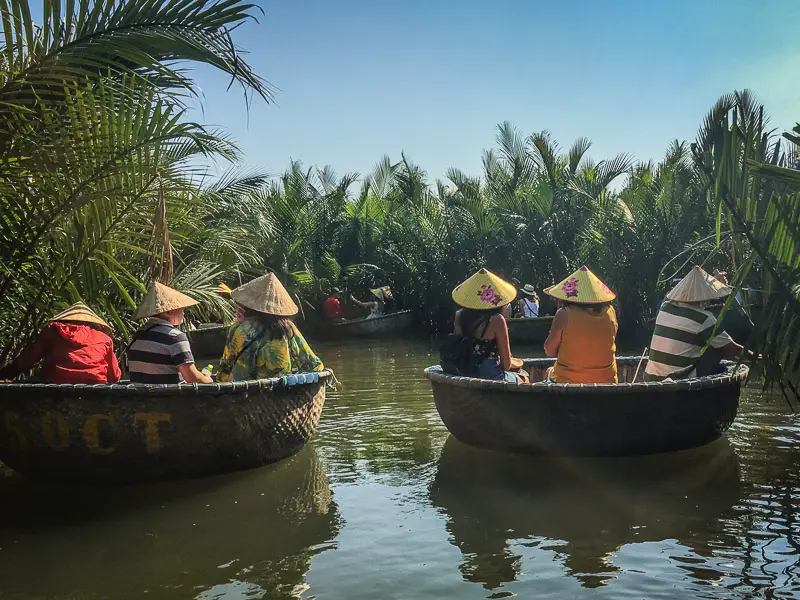
The waters were calm as we drifted through the water coconut plants wearing our Non La (conical hat)
The ride through the picturesque water coconut plantation in the basket boat was more tranquil than I had imagined. The route also took us through a small fishing village where there was an obligatory local throwing a fishing net off his boat to the delight of the cameras, and we hunted for crabs Bear Grills style using a line and a piece of cooked shrimp.
Lucky we weren’t relying on catching crabs for our lunch.
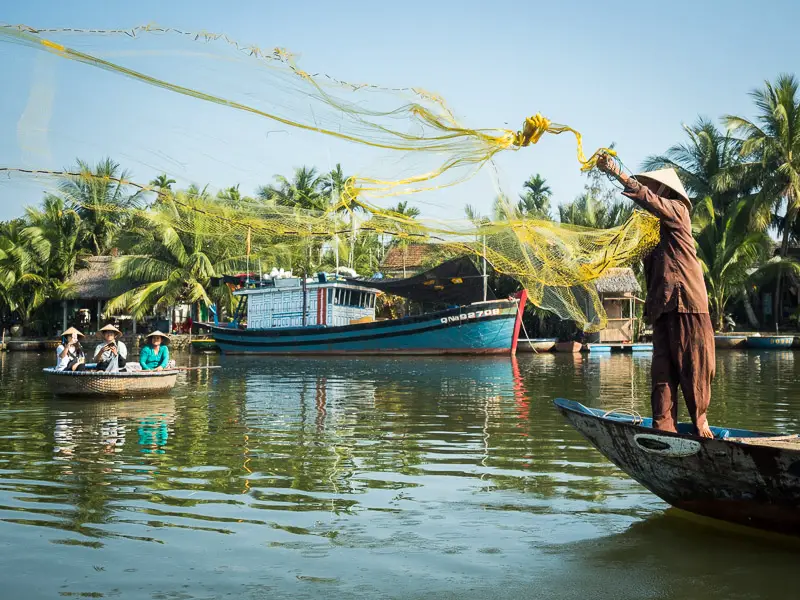
Unfortunately he didn’t seem to be catching any fish.
Back at the cooking class and the group was split into two to make the process more efficient.
As mentioned above, one of the experiences was participating in the making of rice paper (banh trang). The process starts by pounding the rice to remove the husk, before adding the rice and some water to a heavy stone grinder to produce the rice batter. This rice batter is then spread, in a circular motion, over a cloth that is stretched over a large pot of boiling water.
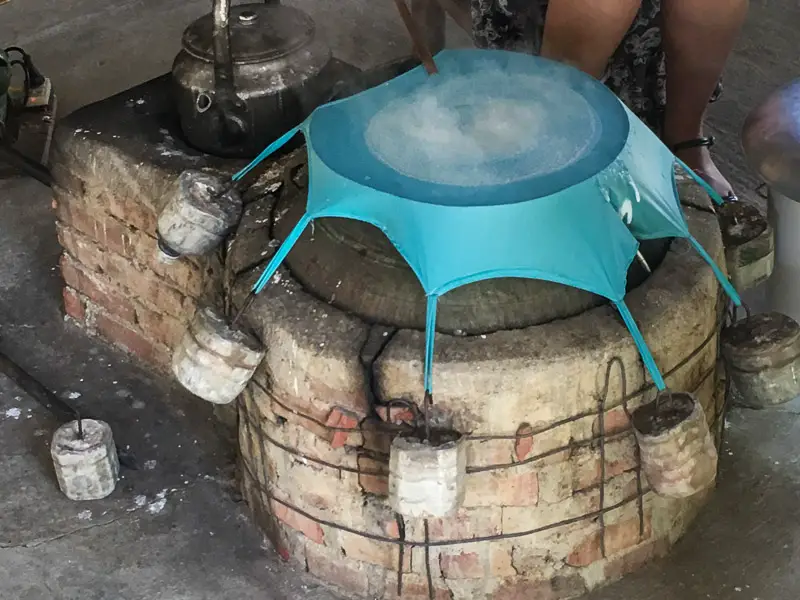
Above: Steaming the rice paper over boiling water. Below Left: Pounding the husk off the rice Below Right: Grinding the rice and water to make rice milk.
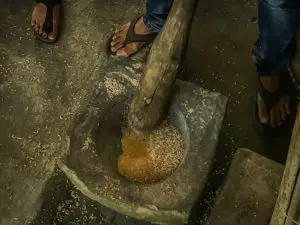
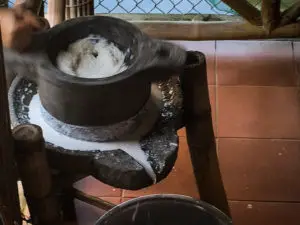
The cloth is then covered with lid for 15 seconds and the rice paper is ready to be removed using a thin stick. It was educational and fun and everyone gets to participate.
Onto the cooking and the dishes are completed one by one. The instructions are clear and easy to follow, with someone always on hand to provide guidance, or help, if needed.
The first dish prepared is the classic fresh spring roll with tofu being used instead of pork and shrimp (which tend to be the ingredients used more often). Luckily they were to be eaten as soon as they were made and this was a welcome as most people were hungry by this stage.
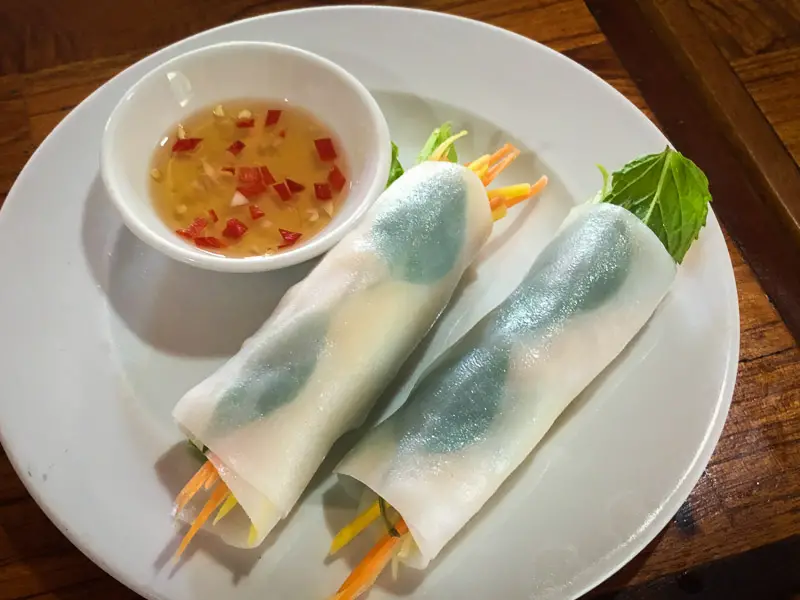
I’m not sure why I have an errant mint leaf sticking out the top of my fresh spring roll. No attention to detail obviously!
The other dishes we prepared were:
Sweet and sour fish sauce – this is the classic Vietnamese dipping sauce
Banana Flower Salad with Shrimp – thinly sliced banana flower with grated carrots, spring onions, herbs, shrimp, and a range of other ingredients to make a fresh and healthy salad.
Banh Xeo – the golden crispy rice milk pancake with a pork and bean sprout filling.
Aubergine (egg plant) with a sticky tomato, soy, and oyster sauce topping. This was my favourite dish of the day, and I’ll be using that sauce for other dishes.
Pho Bo – the classic beef noodle soup, and my favourite Vietnamese breakfast dish, was also prepared by the cooks (not the students) and I guess this was for students to try the noodle soup if they hadn’t already while in Vietnam, and to show a few of the important steps including the addition of star anise and cinnamon.
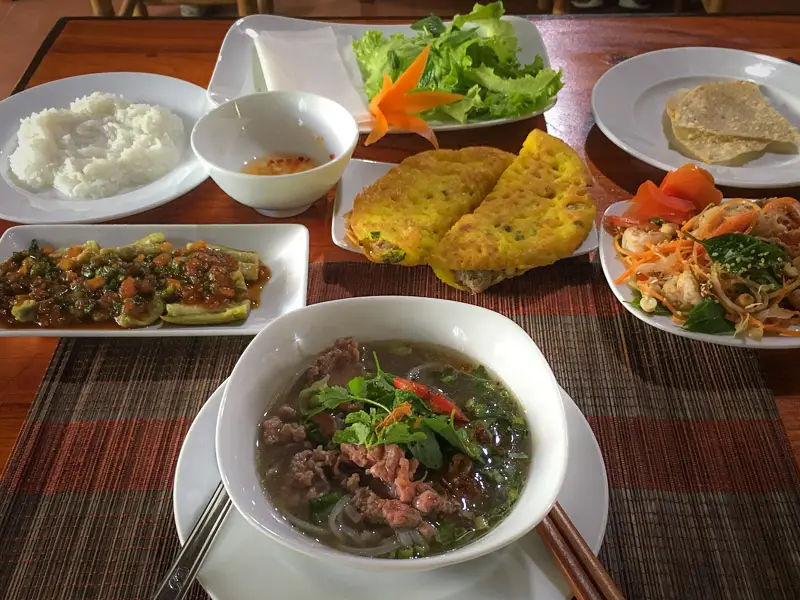
How appetising do those dishes look. And despite the awesome taste, there was no way anyone was going to finish everything.
Once the cooking was completed, we all sat down to a hearty and delicious lunch. There was no shortage of food, and everyone left happy and full.
Tips and observations for the Hoi An Eco Cooking Class
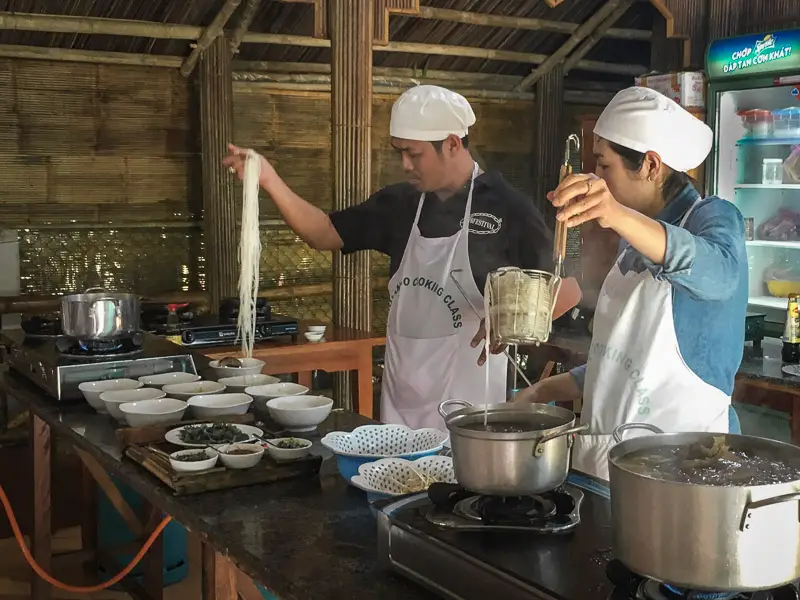
Preparing the pho bo (beef noodle soup
– The price is a reasonable $32 per person (as at Feb 2019). There are cheaper cooking classes in Hoi An, but without the additional extras.
– I was pleasantly surprised at the level of enthusiasm the staff at Hoi An Eco Cooking Class had throughout the class, including from the owner Mr Kien, who continues to show a level of passion despite running a busy little operation.
– Classes are in English
– Booking ahead is important, especially if there are a few of you. I booked 3 days in advance and got the final spot for that day
– There is a timetable and this is adhered to. This is important if you have other plans during the day.
– Chilled water is provided, although I don’t remember if coffee was available. I didn’t see any, but also I didn’t ask either.
– You will receive the recipes and a cool little gift at the end.
– There are two classes per day with the afternoon class not including a visit to the market.
– There are a number of Hoi An cooking classes that have similar names, and experiences, to this class. I’m sure all cooking classes in Hoi An are very good, especially given the competition, but if you are looking to book this particular class, email Mr Kien on sales@hoianecocookingclass.com or call him direct on +84 (0) 983084085. If you book through your hotel, you may end up on a “different” Hoi An Eco Cooking Class experience. You can check out their Facebook page here.
And I think it’s probably worth pointing out that despite this post sounding like an advertisement in places, I’m actually not affiliated in any way with the Hoi An Eco Cooking Class. I just really enjoyed my time and wanted to pass on the positive experience I had during the class.
Further reading: How to get from Da Nang to Hoi An – the complete guide

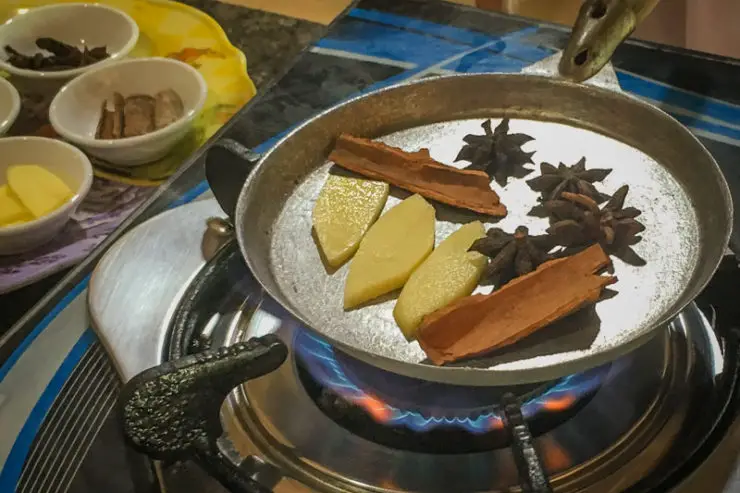
Sounds like a great class. How were your Banh Trang making skills? Any improvement?
My Bang Tang skills remain the same as last time, Cam. There is no improvement on perfection 😉